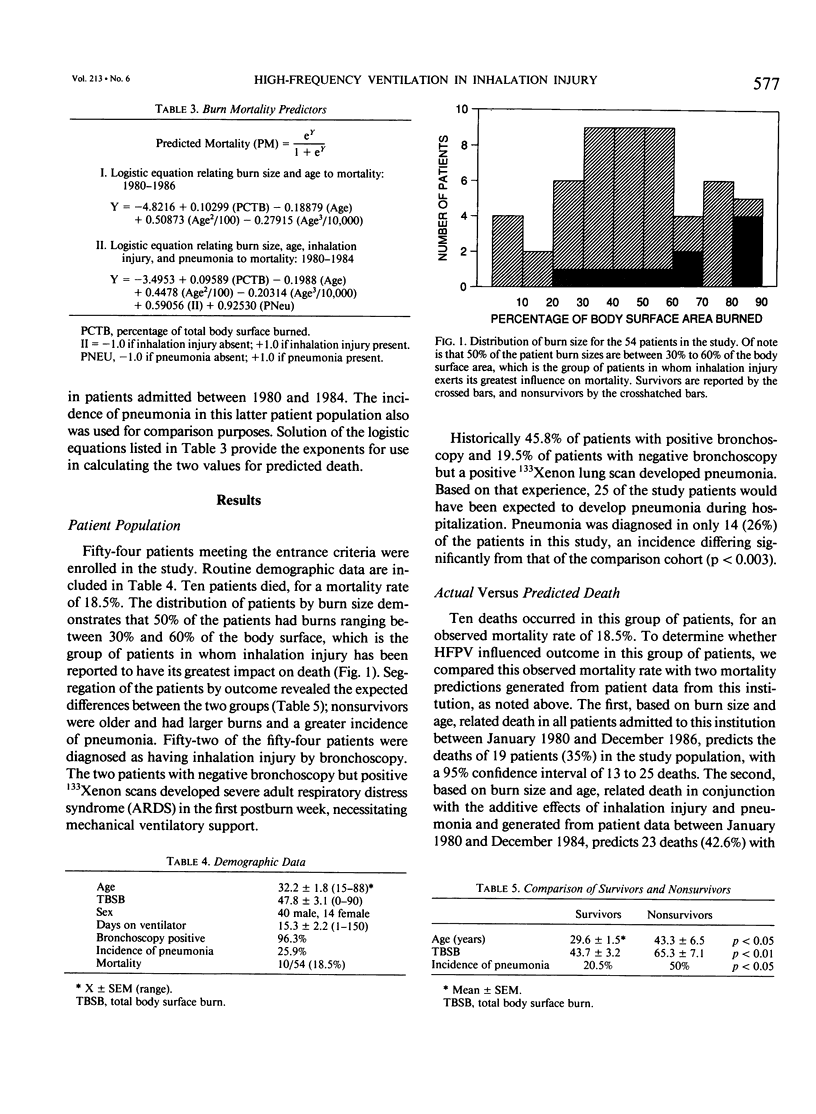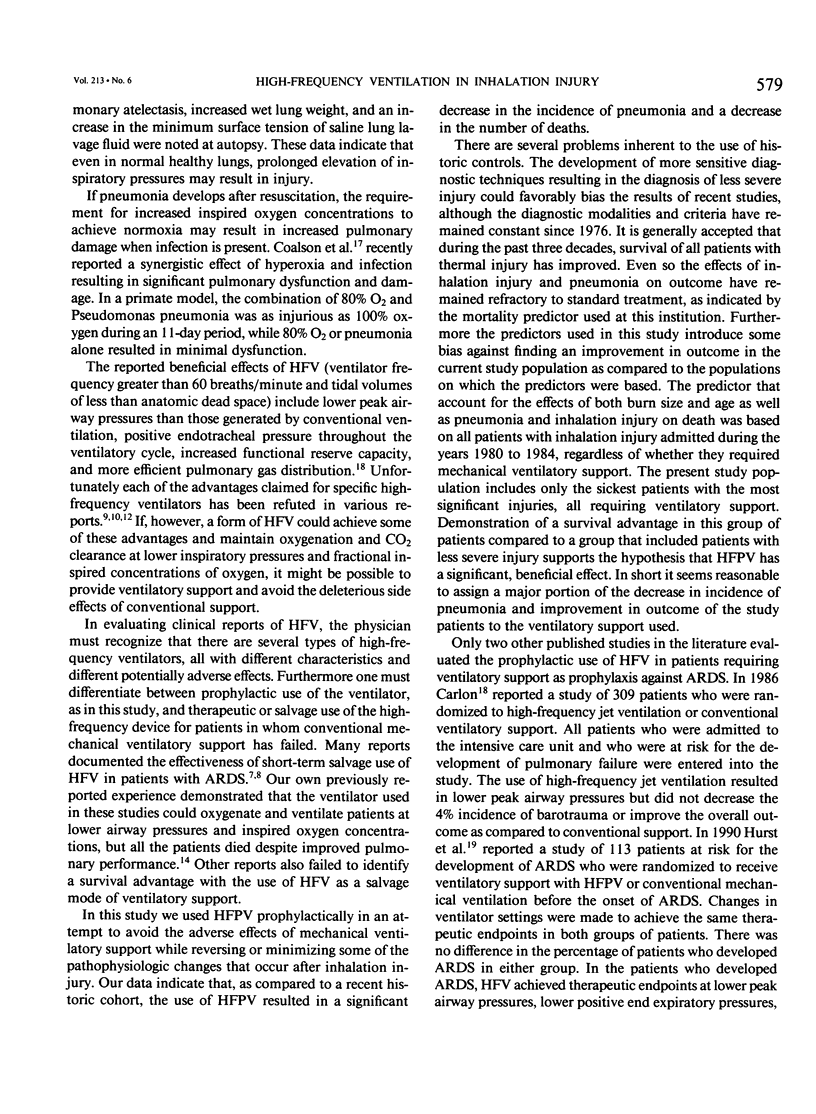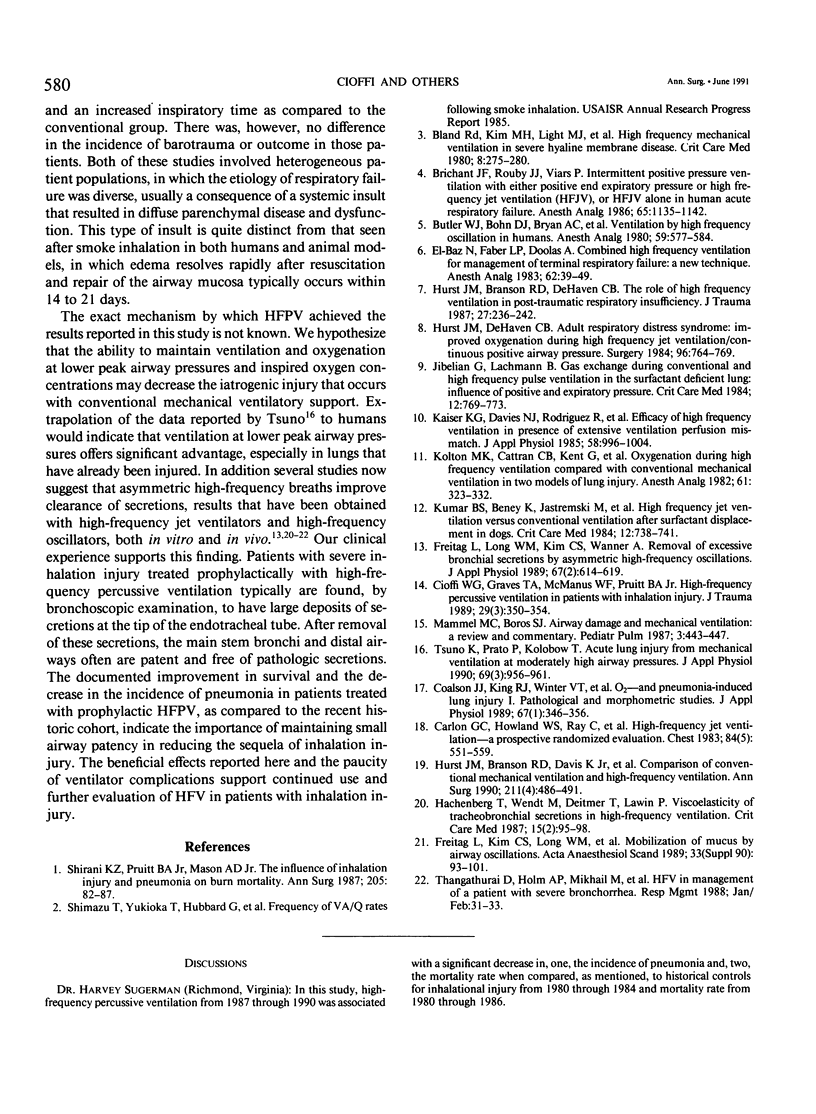Abstract
Death and the incidence of pneumonia are significantly increased in burn patients with inhalation injury, despite application of conventional ventilatory support techniques. The effect of high-frequency percussive ventilation on mortality rate, incidence of pulmonary infection, and barotrauma were studied in 54 burn patients with documented inhalation injury admitted between March 1987 and September 1990 as compared to an historic cohort treated between 1980 and 1984. All patients satisfied clinical criteria for mechanical ventilation. High-frequency percussive ventilation was initiated within 24 hours of intubation. The patients' mean age and burn size were 32.2 years and 47.8%, respectively (ranges, 15 to 88 years; 0% to 90%). The mean number of ventilator days was 15.3 +/- 16.7 (range, 1 to 150 days), with 26% of patients ventilated for more than 2 weeks. Fourteen patients (25.9%) developed pneumonia compared to an historic frequency of 45.8% (p less than 0.005). Mortality rate was 18.5% (10 patients) with an expected historic number of deaths of 23 (95% confidence limits of 17 to 28 deaths). The documented improvement in survival rate and decrease in the incidence of pneumonia in patients treated with prophylactic high-frequency ventilation (HFV), as compared to a cohort of patients treated in the 7 years before the trial, indicates the importance of small airway patency in the pathogenesis of inhalation injury sequelae and supports further use and evaluation of HFV.
Full text
PDF





Selected References
These references are in PubMed. This may not be the complete list of references from this article.
- Bland R. D., Kim M. H., Light M. J., Woodson J. L. High frequency mechanical ventilation in severe hyaline membrane disease an alternative treatment? Crit Care Med. 1980 May;8(5):275–280. doi: 10.1097/00003246-198005000-00001. [DOI] [PubMed] [Google Scholar]
- Brichant J. F., Rouby J. J., Viars P. Intermittent positive pressure ventilation with either positive end-expiratory pressure or high frequency jet ventilation (HFJV), or HFJV alone in human acute respiratory failure. Anesth Analg. 1986 Nov;65(11):1135–1142. [PubMed] [Google Scholar]
- Butler W. J., Bohn D. J., Bryan A. C., Froese A. B. Ventilation by high-frequency oscillation in humans. Anesth Analg. 1980 Aug;59(8):577–584. [PubMed] [Google Scholar]
- Carlon G. C., Howland W. S., Ray C., Miodownik S., Griffin J. P., Groeger J. S. High-frequency jet ventilation. A prospective randomized evaluation. Chest. 1983 Nov;84(5):551–559. doi: 10.1378/chest.84.5.551. [DOI] [PubMed] [Google Scholar]
- Cioffi W. G., Graves T. A., McManus W. F., Pruitt B. A., Jr High-frequency percussive ventilation in patients with inhalation injury. J Trauma. 1989 Mar;29(3):350–354. doi: 10.1097/00005373-198903000-00012. [DOI] [PubMed] [Google Scholar]
- Coalson J. J., King R. J., Winter V. T., Prihoda T. J., Anzueto A. R., Peters J. I., Johanson W. G., Jr O2- and pneumonia-induced lung injury. I. Pathological and morphometric studies. J Appl Physiol (1985) 1989 Jul;67(1):346–356. doi: 10.1152/jappl.1989.67.1.346. [DOI] [PubMed] [Google Scholar]
- El-Baz N., Faber L. P., Doolas A. Combined high-frequency ventilation for management of terminal respiratory failure: a new technique. Anesth Analg. 1983 Jan;62(1):39–49. [PubMed] [Google Scholar]
- Freitag L., Kim C. S., Long W. M., Venegas J., Wanner A. Mobilization of mucus by airway oscillations. Acta Anaesthesiol Scand Suppl. 1989;90:93–101. doi: 10.1111/j.1399-6576.1989.tb03012.x. [DOI] [PubMed] [Google Scholar]
- Freitag L., Long W. M., Kim C. S., Wanner A. Removal of excessive bronchial secretions by asymmetric high-frequency oscillations. J Appl Physiol (1985) 1989 Aug;67(2):614–619. doi: 10.1152/jappl.1989.67.2.614. [DOI] [PubMed] [Google Scholar]
- Hachenberg T., Wendt M., Deitmer T., Lawin P. Viscoelasticity of tracheobronchial secretions in high-frequency ventilation. Crit Care Med. 1987 Feb;15(2):95–98. doi: 10.1097/00003246-198702000-00002. [DOI] [PubMed] [Google Scholar]
- Hurst J. M., Branson R. D., Davis K., Jr, Barrette R. R., Adams K. S. Comparison of conventional mechanical ventilation and high-frequency ventilation. A prospective, randomized trial in patients with respiratory failure. Ann Surg. 1990 Apr;211(4):486–491. doi: 10.1097/00000658-199004000-00017. [DOI] [PMC free article] [PubMed] [Google Scholar]
- Hurst J. M., Branson R. D., DeHaven C. B. The role of high-frequency ventilation in post-traumatic respiratory insufficiency. J Trauma. 1987 Mar;27(3):236–242. doi: 10.1097/00005373-198703000-00002. [DOI] [PubMed] [Google Scholar]
- Hurst J. M., DeHaven C. B. Adult respiratory distress syndrome: improved oxygenation during high-frequency jet ventilation/continuous positive airway pressure. Surgery. 1984 Oct;96(4):764–769. [PubMed] [Google Scholar]
- Jibelian G., Lachmann B. Gas exchange during conventional and high-frequency pulse ventilation in the surfactant-deficient lung: influence of positive end-expiratory pressure. Crit Care Med. 1984 Sep;12(9):769–773. doi: 10.1097/00003246-198409000-00018. [DOI] [PubMed] [Google Scholar]
- Kaiser K. G., Davies N. J., Rodriguez-Roisin R., Bencowitz H. Z., Wagner P. D. Efficacy of high-frequency ventilation in presence of extensive ventilation-perfusion mismatch. J Appl Physiol (1985) 1985 Mar;58(3):996–1004. doi: 10.1152/jappl.1985.58.3.996. [DOI] [PubMed] [Google Scholar]
- Kolton M., Cattran C. B., Kent G., Volgyesi G., Froese A. B., Bryan A. C. Oxygenation during high-frequency ventilation compared with conventional mechanical ventilation in two models of lung injury. Anesth Analg. 1982 Apr;61(4):323–332. [PubMed] [Google Scholar]
- Kumar B. S., Beney K., Jastremski M., Nieman G., Bredenberg C. High-frequency jet ventilation versus conventional ventilation after surfactant displacement in dogs. Crit Care Med. 1984 Sep;12(9):738–741. doi: 10.1097/00003246-198409000-00011. [DOI] [PubMed] [Google Scholar]
- Mammel M. C., Boros S. J. Airway damage and mechanical ventilation: a review and commentary. Pediatr Pulmonol. 1987 Nov-Dec;3(6):443–447. doi: 10.1002/ppul.1950030613. [DOI] [PubMed] [Google Scholar]
- Shirani K. Z., Pruitt B. A., Jr, Mason A. D., Jr The influence of inhalation injury and pneumonia on burn mortality. Ann Surg. 1987 Jan;205(1):82–87. doi: 10.1097/00000658-198701000-00015. [DOI] [PMC free article] [PubMed] [Google Scholar]
- Tsuno K., Prato P., Kolobow T. Acute lung injury from mechanical ventilation at moderately high airway pressures. J Appl Physiol (1985) 1990 Sep;69(3):956–961. doi: 10.1152/jappl.1990.69.3.956. [DOI] [PubMed] [Google Scholar]


